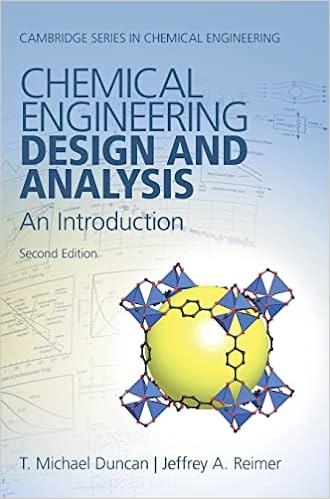Question
Sodium bicarbonate is synthesized by reacting sodium carbonate with carbon dioxide and water at 70C and 2.0 atm (gauge): Na2CO3+CO2+H20 -> 2NaHCO3 An aqueous solution
Sodium bicarbonate is synthesized by reacting sodium carbonate with carbon dioxide and water at 70C and 2.0 atm (gauge):
Na2CO3+CO2+H20 -> 2NaHCO3
An aqueous solution containing 7.00 wt% sodium carbonate and a gas stream containing 70.0 mole% CO2 and the balance air are fed to the reactor. All of the sodium carbonate and some of the carbon dioxide in the feed react. The gas leaving the reactor, which contains the air and unreacted CO2, is saturated with water vapor at the reactor conditions. A liquidsolid slurry of sodium bicarbonate crystals in a saturated aqueous solution containing 2.4 wt% dissolved sodium bicarbonate and a negligible amount of dissolved CO2 leaves the reactor and is pumped to a filter. The wet filter cake contains 86 wt% sodium bicarbonate crystals and the balance saturated solution, and the filtrate also is a saturated solution. The production rate of solid crystals is 500 kg/h. Suggestion: Although the problems to be given can be solved in terms of the product flow rate of 500 kg NaHCO3(s)/h, it might be easier to assume a different basis and then scale the process to the desired production rate of crystals.
a. Calculate the composition (component mole fractions) and volumetric flow rate (m3/min) of the gas stream leaving the reactor.
b. Calculate the feed rate of gas to the process in standard cubic meters/min [m3(STP)/min].
c. Calculate the flow rate (kg/h) of the liquid feed to the process. What more would you need to know to calculate the volumetric flow rate of this stream?
d. The filtrate was assumed to leave the filter as a saturated solution at 70C. What would be the effect on your calculations if the temperature of the filtrate actually dropped to 50C as it passed through the filter?
e. The reactor pressure of 2 atm gauge was arrived at in an optimization study. What benefit do you suppose would result from increasing the pressure? What penalty would be associated with this increase? The term Henrys law should appear in your explanation. (Hint: The reaction occurs in the liquid phase and the CO2 enters the reactor as a gas. What step must precede the reaction?)
Step by Step Solution
There are 3 Steps involved in it
Step: 1

Get Instant Access to Expert-Tailored Solutions
See step-by-step solutions with expert insights and AI powered tools for academic success
Step: 2

Step: 3

Ace Your Homework with AI
Get the answers you need in no time with our AI-driven, step-by-step assistance
Get Started


